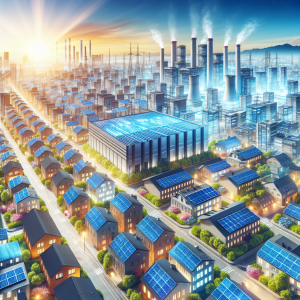Solar Power Integration in Urban Environments
Urban environments worldwide are increasingly turning to solar power integration as a viable solution to meet energy demands while promoting sustainability. The strategic use of solar power in cities plays a critical role in reducing greenhouse gas emissions, improving energy efficiency, and fostering resilience against climate change. By leveraging the rooftops, facades, and every available surface, cities can transform into a network of solar power generators, driving a new era of urban energy solutions.
Solar architecture is at the forefront of this transformation, with building-integrated photovoltaics (BIPV) becoming a key focus. These systems incorporate solar panels seamlessly into building materials such as rooftops, walls, and windows, providing a dual function of structural aesthetics and energy production. As urban populations grow, so does the demand for sustainable building designs. Integrating BIPV within urban landscapes can significantly reduce reliance on traditional energy sources, providing an eco-friendly alternative that harmonizes with urban aesthetics.
Automation and smart technology are crucial for the effective integration of solar power in cities. Smart grids enable efficient energy distribution and management, facilitating real-time data analysis for optimal performance. By using sensors and IoT technology, these systems can automatically adjust to the city’s energy needs, enhancing efficiency and reliability. The intelligent coordination of energy consumption through smart grids allows for reduced energy wastage and maximizes the benefits of solar energy.
Urban planners and policymakers play an essential role in facilitating solar power integration. Zoning laws, building codes, and incentives must encourage the adoption of solar technologies. Policies can include mandates for solar-ready construction, tax incentives, and rebates for solar installations. Moreover, creating urban solar farms can help optimize land use, transforming underutilized spaces like parking lots and abandoned industrial areas into solar energy hubs.
In discussing the financial aspects, the decreasing cost of solar technology has been pivotal in its urban adoption. Over the past decade, solar panel prices have plummeted, making them more accessible for residential and commercial use. Moreover, government incentives and financing options such as power purchase agreements (PPA) and solar leasing further reduce the financial barriers, making solar installations an attractive investment in urban settings.
Community solar projects have further democratized access to solar power. These projects involve shared solar power systems, allowing multiple urban residents or businesses who are unable to install solar panels on their property to benefit from solar energy. By subscribing to a share of the solar farm’s output, participants save on energy costs and support renewable energy, promoting communal sustainability efforts.
The capacity of urban areas to integrate solar power is linked to innovation in storage solutions. Developments in battery technology, such as lithium-ion and emerging solid-state batteries, provide efficient energy storage options. These technologies ensure a steady supply of power, even when solar energy generation is low, such as during cloudy days or nights, enhancing the reliability of solar power in urban areas.
Public awareness and education are integral to fostering solar power adoption in cities. Initiatives that inform the public about the benefits and feasibility of solar energy can drive community engagement and support. Schools and community organizations can host workshops and informational campaigns, empowering residents with the knowledge to make informed decisions about their energy consumption and encouraging wider adoption of solar technologies.
Challenges remain in the integration of solar power in dense urban environments, including limited space and shading from tall buildings. Innovative solutions like vertical solar farms and innovative architectural designs are emerging to address these issues. Additionally, advancements in solar panel efficiency and flexibility, including bifacial panels and thin-film technologies, are making it easier to harness solar energy in constrained urban spaces.
Environmental considerations extend beyond energy production, as solar power contributes to cooling urban temperatures and improving air quality. By replacing traditional roofing materials with solar panels, the urban heat island effect can be mitigated, creating a cooler urban environment. Furthermore, reducing reliance on fossil fuels decreases air pollution, contributing to healthier city living conditions.
Navigating the future of urban energy relies on adopting a holistic approach to infrastructure development that incorporates renewable energy solutions. The integration of solar power in urban landscapes exemplifies a forward-thinking strategy aiming not only at sustainability but also at enhancing urban resilience and energy independence. Cities investing in solar power are setting a benchmark for a sustainable urban future, paving the way for generations of clean energy cities that thrive on renewable resources.
Optimal urban solar integration calls for collaboration among architects, engineers, policymakers, and residents, all working towards a common goal of sustainable urban living. This collaborative effort can champion the transition towards renewable energy, establishing solar power as a backbone of urban energy infrastructures and aligning with global goals for carbon neutrality and environmental stewardship.



